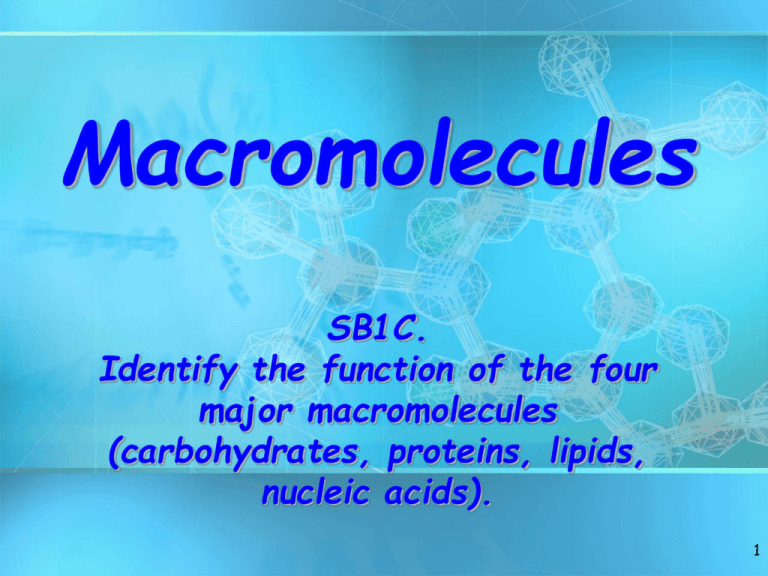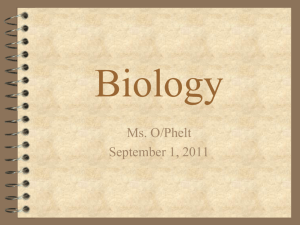Macromolecules PowerPoint
advertisement

Macromolecules SB1C. Identify the function of the four major macromolecules (carbohydrates, proteins, lipids, nucleic acids). 1 Organic Compounds • Compounds that contain CARBON are called organic. • Macromolecules are large organic molecules. 2 Macromolecules • Large organic molecules. • Also called POLYMERS. • Made up of smaller “building blocks” called MONOMERS or SUBUNITS. • Examples: 1. Carbohydrates 2. Lipids 3. Proteins 4. Nucleic acids (DNA and RNA) 3 Carbohydrates 4 Carbohydrates • Small sugar molecules to large sugar molecules. • Made up of C,H,O 1:2:1 • Examples: A. monosaccharide B. disaccharide C. polysaccharide 5 Carbohydrates Subunit: Monosaccharide-one sugar unit Examples: glucose glucose (C6H12O6) deoxyribose ribose Fructose Galactose 6 Carbohydrates Disaccharide: two sugar unit Examples: – Sucrose (glucose+fructose) – Lactose (glucose+galactose) – Maltose (glucose+glucose) glucose glucose 7 Carbohydrates Polysaccharide: many sugar units Examples: starch (bread, potatoes) glycogen (beef muscle) cellulose (lettuce, corn) glucose glucose glucose glucose cellulose glucose glucose glucose glucose 8 Lipids 9 What are Lipids? • General term for compounds which are not soluble in water. • Lipids are soluble in hydrophobic solvents. • Elements: C,H,O 10 Lipids Subunit: Triglycerides are composed of 1 glycerol and 3 fatty acids. H O H-C----O C-CH2-CH2-CH2-CH2-CH2-CH2-CH2-CH2-CH2-CH3 O H-C----O C-CH2-CH2-CH2-CH2-CH2-CH2-CH2-CH2-CH2-CH3 O fatty acids H-C----O C-CH -CH -CH -CH 2 2 2 H glycerol 11 Lipids • Function: “stores the most energy” • Examples: 1. Fats 2. Phospholipids 3. Oils 4. Waxes 5. Steroid hormones 6. Triglycerides 12 Lipids Six functions of lipids: 1. Long term energy storage 2. Protection against heat loss (insulation) 3. Protection against physical shock 4. Protection against water loss 5. Chemical messengers (hormones) 6. Major component of membranes (phospholipids) 13 Proteins 14 Proteins (Polypeptides) • Amino acids (20 different kinds of aa) bonded together by peptide bonds (polypeptides). • Elements: C, H, O, N, and sometimes S 15 Proteins (Polypeptides) • Six functions and 1. Storage: 2. Transport: 3. Regulatory: 4. Movement: 5. Structural: 6. Enzymes: examples of proteins: albumin (egg white) hemoglobin hormones muscles membranes, hair, nails cellular reactions 16 Nucleic Acids 17 Nucleic acids • Nucleic acids are used for storing and transmitting genetic information • Two types: a. Deoxyribonucleic acid (DNAdouble helix) b. Ribonucleic acid (RNA-single strand) • Elements: C,H,O,N,P 18 Nucleic acids • Subunit: Nucleotides – Parts: phosphate group pentose sugar (5-carbon) nitrogenous bases: adenine (A) thymine (T) DNA only uracil (U) RNA only cytosine (C) guanine (G) 19 Nucleotide Phosphate Group O O=P-O O 5 CH2 O N C1 C4 Nitrogenous base (A, G, C, or T) Sugar (deoxyribose) C3 C2 20 5 DNA double helix O 3 3 O P 5 O C G 1 P 5 3 2 4 4 2 3 1 P T 5 A P 3 O O P 5 O 3 5 P 21





